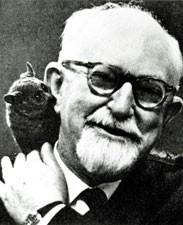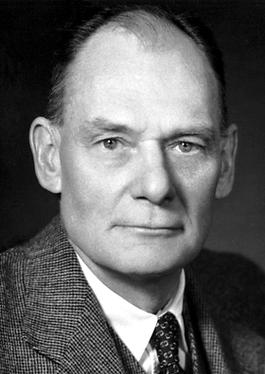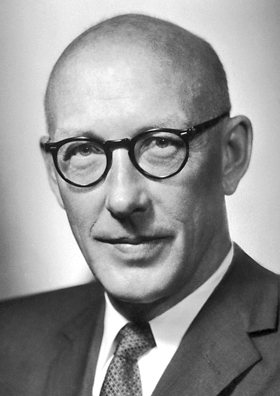
Alexander Emmanuel Rodolphe Agassiz, son of Louis Agassiz and stepson of Elizabeth Cabot Agassiz, was an American scientist and engineer.

The Dictionary of National Biography (DNB) is a standard work of reference on notable figures from British history, published since 1885. The updated Oxford Dictionary of National Biography (ODNB) was published on 23 September 2004 in 60 volumes and online, with 50,113 biographical articles covering 54,922 lives.

Alexei Alexeyevich Abrikosov was a Soviet, Russian and American theoretical physicist whose main contributions are in the field of condensed matter physics. He was the co-recipient of the 2003 Nobel Prize in Physics, with Vitaly Ginzburg and Anthony James Leggett, for theories about how matter can behave at extremely low temperatures.

George Gaylord Simpson was an American paleontologist. Simpson was perhaps the most influential paleontologist of the twentieth century, and a major participant in the modern synthesis, contributing Tempo and Mode in Evolution (1944), The Meaning of Evolution (1949) and The Major Features of Evolution (1953). He was an expert on extinct mammals and their intercontinental migrations. Simpson was extraordinarily knowledgeable about Mesozoic fossil mammals and fossil mammals of North and South America. He anticipated such concepts as punctuated equilibrium and dispelled the myth that the evolution of the horse was a linear process culminating in the modern Equus caballus. He coined the word hypodigm in 1940, and published extensively on the taxonomy of fossil and extant mammals. Simpson was influentially, and incorrectly, opposed to Alfred Wegener's theory of continental drift, but accepted the theory of plate tectonics when the evidence became conclusive.

John Franklin Enders was an American biomedical scientist and Nobel Laureate. Enders has been called "The Father of Modern Vaccines."

Edward Singleton Holden was an American astronomer and the fifth president of the University of California.

Edward Lawrie Tatum was an American geneticist. He shared half of the Nobel Prize in Physiology or Medicine in 1958 with George Beadle for showing that genes control individual steps in metabolism. The other half of that year's award went to Joshua Lederberg. Tatum was an elected member of the United States National Academy of Sciences, the American Philosophical Society, and the American Academy of Arts and Sciences.

Frank Alexander Wetmore was an American ornithologist and avian paleontologist. He was the sixth Secretary of the Smithsonian Institution. He was also an elected member of both the American Philosophical Society and the United States National Academy of Sciences.

Who's Who is a reference work. It has been published annually in the form of a hardback book since 1849, and has been published online since 1999. It has also been published on CD-ROM. It lists, and gives information on, people from around the world who influence British life. Entries include notable figures from government, politics, academia, business, sport and the arts. Who's Who 2023 is the 175th edition and includes more than 33,000 people.

Edward Joseph Leonski was a United States Army soldier and serial killer responsible for the strangling murders of three women in Melbourne, Australia in 1942. Leonski was dubbed The Brownout Strangler, after Melbourne's wartime practice of dropping the electricity voltage to conserve energy. His self-confessed motive for the killings was a twisted fascination with female voices, especially when they were singing, and his claim that he killed the women to "get their voices".

William Henry Holmes, known as W. H. Holmes, was an American explorer, anthropologist, archaeologist, artist, scientific illustrator, cartographer, mountain climber, geologist and museum curator and director.

Joseph Sweetman Ames was an American physicist, professor at Johns Hopkins University, provost of the university from 1926 to 1929, and university president from 1929 to 1935. He is best remembered as one of the founding members of the National Advisory Committee for Aeronautics and its longtime chairman (1919–1939). NASA Ames Research Center is named after him. He was elected to the American Philosophical Society in 1905 and the United States National Academy of Sciences in 1909. He was elected a Fellow of the American Academy of Arts and Sciences in 1911. He was the 1935 recipient of the Langley Gold Medal from the Smithsonian Institution.

A biography, or simply bio, is a detailed description of a person's life. It involves more than just basic facts like education, work, relationships, and death; it portrays a person's experience of these life events. Unlike a profile or curriculum vitae (résumé), a biography presents a subject's life story, highlighting various aspects of their life, including intimate details of experience, and may include an analysis of the subject's personality.
Marquis Who's Who, also known as A.N. Marquis Company, is an American publisher of a number of directories containing short biographies. The books usually are entitled Who's Who in... followed by some subject, such as Who's Who in America, Who's Who of American Women, Who's Who in Asia, Who's Who in the World, Who's Who in Science and Engineering, Who's Who in American Politics, etc. Often, Marquis Who's Who books are found in the reference section of local libraries, at corporate libraries, and are also used for research by universities.

Josiah Parsons Cooke was an American chemist who worked at Harvard University and was instrumental in the measurement of atomic weights, inspiring America's first Nobel laureate in chemistry, Theodore William Richards, to pursue similar research. Cooke's 1854 paper on atomic weights has been said to foreshadow the periodic law developed later by Mendeleev and others. Historian I. Bernard Cohen described Cooke "as the first university chemist to do truly distinguished work in the field of chemistry" in the United States.
Contemporary Authors is a reference work that has been published by Gale since 1962. The work provides short biographies and bibliographies of contemporary and near-contemporary writers and is a major source of information on over 116,000 living and deceased authors from around the world. The work is a standard in libraries and has been honored by the American Library Association as a distinguished reference title.
William Albert Noyes Jr., commonly known as W. Albert Noyes Jr., was an American chemist known for his contributions to photochemistry. During World War II, he was a leader in U.S. defense research efforts. He chaired the chemistry department at the University of Rochester, edited several important chemistry journals, and throughout his career was a prominent voice for international scientific cooperation. He was the son of the renowned chemist William A. Noyes; they became the first father-son pair to win the Priestley Medal, the highest honor given by the American Chemical Society.

Erwin Frink Smith was an American plant pathologist with the United States Department of Agriculture. He played a major role in demonstrating that bacteria could cause plant disease.

Membership of the National Academy of Sciences is an award granted to scientists that the National Academy of Sciences (NAS) of the United States judges to have made “distinguished and continuing achievements in original research”. Membership is a mark of excellence in science and one of the highest honors that a scientist can receive.
Herbert Friedman was an American physicist and astronomer who did research in X-ray astronomy. During his career Friedman published hundreds of scientific papers. One such example is "Ultraviolet and X Rays from the Sun". Friedman worked at the Naval Research Laboratory (NRL) the entirety of his professional career, from 1940-1980. He was elected to the American Academy of Arts and Sciences and the United States National Academy of Sciences in 1960. He received the Eddington Medal of the Royal Astronomical Society in 1964. That same year, he was elected to the American Philosophical Society. In 1987 he was awarded the Wolf Prize in Physics “for pioneering investigations in solar X-rays”.















